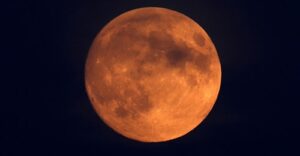How to Watch this Week’s Spectacular “Super Flower Flood Moon” Lunar Eclipse
By Sophie Lewis
“When this happens, the only light that reaches the moon’s surface is from the edges of the Earth’s atmosphere,” the space agency explains. “The air molecules from Earth’s atmosphere scatter out most of the blue light. The remaining light reflects onto the moon’s surface with a red glow, making the moon appear red in the night sky.”
NASA says the result will be a “ring of light” around the moon.
“Just how red it will look is hard to predict, but dust in the atmosphere can have an effect. (And keep in mind there have been a couple of prominent volcanic eruptions recently),” NASA said.
Not only does May bring a lunar eclipse, but also the year’s best supermoon. A supermoon occurs when the moon appears larger than usual in the night sky because it is at its closest point to Earth in its orbit, known as perigee.
May’s full supermoon is known as the “Flower Moon,” and it marks the second of three supermoons this year. It’s appropriately named for the abundance of flowers associated with spring in the Northern Hemisphere.
How to watch
On Wednesday, May 26, the cosmic phenomenon will be at least partly visible anywhere on the night side of the planet, NASA said. Under clear weather conditions, skywatchers around the world will be able to enjoy the show.
This includes parts of Asia and Australia, as well as much of the U.S. and South America. For skywatchers in the U.S., the best viewing will be in Hawaii, Alaska, and the western states, though the eclipse is partially visible further East during dawn twilight. And if you’re in the U.S. you should wake up early to see the rare celestial event.
According to NASA, the peak of the eclipse will last for about 14 minutes, but the entire event will last about five hours, from 08:47:39 UTC (Coordinated Universal Time) to 13:49:41 UTC. It will peak at 11:19:52 UTC.
This means that in Asia, the eclipse occurs in the early evening when the moon first rises, while on the west coast of the Americas, it occurs in the early morning hours, when the moon is setting.
Solar eclipses should never be viewed with the naked eye, but lunar eclipses are completely safe to look at.
Don’t worry if you’re not located in the best place to spot the eclipse. The Virtual Telescope Project will have a live feed of the entire event, starting at 3 a.m. PT on May 26.
